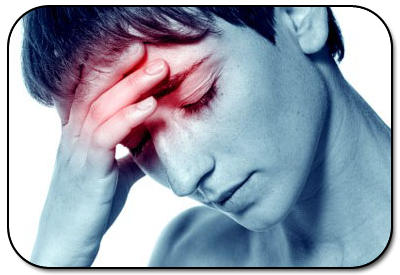Dr. Eric Harter
239-573-7988 (Chiro)
239-772-2266 (Neuropathy)
F: (239) 772-1017
Chiropractic for
Kids & Adults
Walk-ins Welcome!
Abundant Life Chiropractic
1260 NE 8th St #110
Cape Coral, FL 33909

Monday - Friday
8:00am - 6:00pm
Saturdays By
Appointment Only
Walk-ins Welcome!
Headaches and Tension Headaches
What is a Headache?
A headache is defined as a pain in the head or upper neck. It is one of the most common locations of pain in the body and has many causes. Headaches are one of the most commonly treated conditions in chiropractic offices today. There are many different types of headache and they all have different symptoms. Headaches may be located in the back of your head, on the sides, in the front of your head, behind your eyes, forehead and even in the upper part of your neck. The painful symptoms of headaches can range anywhere from a dull ache to a sharp piercing headache. Headaches like migraines or cluster headaches are often quite debilitating.
What Causes Headaches?
There are many causes of headaches including: subluxations (vertebral misalignments), whiplash, nerve interference, tension or stress, bad posture, eye strain, sinuses or allergies, a drop in blood sugar, increase in blood pressure, depression, dehydration, falls, certain food triggers, hormones and even medication causes. For some people headaches are fairly common, however either way headaches are not normal and are your body’s way of telling you something is wrong. Simply covering up the pain of a headache with aspirin, ibuprofen or other OTC medication is ignoring the problem, and if used frequently may be harmful to your body.

What type of headache do I have?
Tension Headache:
The most common headache; the tension headache, frequently occurs and are often worse in the afternoon or early evening. The pain is usually bilateral
(affects both sides of the head), suboccipital (affecting the back of the head) or super orbital (above the eyes) and even be located the upper back and
neck. The headaches often last for days or weeks. Aspirin and over-the-counter medications provide temporary relief.
The cause of a tension type headache is often due to multiple hypertonic (tight) muscles and trigger points in the neck and suboccipital area. Even though there are no diagnostic findings specific to tension type headaches, it is not unusual to find tender trigger points and/or tight muscles in the neck. A history of frequent, often bilateral (both sides of the head), attacks that are relieved by pain medication is a strong basis for a tension like headache diagnosis.
What is a Headache?
Migraine Headache without Aura (Common Migraine):
More common in females, pain from a common migraine is described as unilateral (affecting one side of the head) and pulsatile (throbbing).
The headache is often recurrent with no associated visual disturbances or other neurological signs and symptoms. The pain is severe, however the patient can
usually continue with minor daily activities. Nausea and vomiting can often occur. Vomiting sometimes provides relief from the headache.
Migraines are thought to be neurogenic (caused by brain or nerve tissue). The nerve tissue releases chemicals that cause vascular (blood vessels)
tissue inflammation. This inflammation may cause intense and even debilitating pain. There appears to be a wide variety of migraine triggers, including a
variation in eating/sleeping habits, pollutants, medications, chocolate, caffeine, cheese, wine and nuts. Women may also see a hormonal relationship with migraines.
Migraine Headache with Aura (Classic Migraine):
More common in females, pain from a classic migraine is described as a unilateral throbbing headache that is preceded by visual and auditory
disturbances. The visual disturbances are often blind spots or flashing lights may last for about 30 minutes and become slowly replaced by a disabling headache
that can last hours or even days. A classic migraine headache will often cause a person to seek a dark quiet environment. There is often associated nausea and
vomiting with any migraine headache. Vomiting sometimes provides relief from the headache. There is a family history of similar headaches.
Migraines are thought to be neurogenic (caused by brain or nerve tissue). The nerve tissue releases chemicals that cause vascular (blood vessel) tissue
inflammation. This inflammation may cause intense and even debilitating pain. Other chemicals (vasoconstrictors) constrict blood vessels in the brain and
restrict blood flow to the visual and auditory parts of the brain causing visual and auditory disturbances. There appears to be a wide variety of migraine
triggers, including a variation in eating/sleeping habits, pollutants, medications, chocolate, caffeine, cheese, wine and nuts. Women may also see a hormonal
relationship with migraines.
Cluster Headache:
More common at night and amongst middle – aged males, this headache is severely painful and located around or behind the eyes. Cluster headaches can last
days or weeks end, and then appears several months later. An average cluster headache may last 30 minutes. Alcohol, smoking and certain foods can often trigger
cluster headaches.
Temporal Arteritis:
Patient is 50+ and complaints of unilateral headache in the temporal region the headache is often associated with pain to the touch around the temples.
General aching and muscular fatigue in the upper trunk is also common. A person may also complain of visual dysfunction or blindness that occurs suddenly. This
type of headache is caused by increased inflammation in the blood vessels and is a medical emergency.
Please go to emergency room immediately.
What can I do for my headache?
Chiropractic/Acupuncture Care is a phenomenal drug free, non-invasive approach to treating/dealing with all types of headaches. A subluxations (vertebra out of place) will apply undue stress to your nervous system and then nerves innervating them musculature in your neck. When nerves are interfered with, muscles get an improper signal to contract. Prolonged contraction of muscles cause "trigger points". Aspirin or ibuprofen cannot reduce the nerve interference and thus will not fix the problem. They may help ease the headache, but the same problem comes back the next day or the next week because structurally your neck is still out of alignment the same. Here at Abundant Life Chiropractic we get to the root of the problem and deal with that. We will work to change vertebral alignment (subluxations), through specific chiropractic adjustments, postural correction, diet/ life style modifications, and supply you exercises/rehab to make sure your headaches become a thing of the past. We have great success in treating patients with headaches, stop on by and let us help you out.
Once my headache stops, does the chiropractic care end?
Your body continues to heal after the pain has gone. Continuing to have chiropractic adjustments, will help retrain your nervous system to hold its healthy positions thus eliminate headaches. Your nervous system will function more efficiently and your body will be better able to heal itself. In time, exercise, a healthy diet, and periodic visits to the chiropractor will help you stay healthy, pain free, and live life to the fullest.
